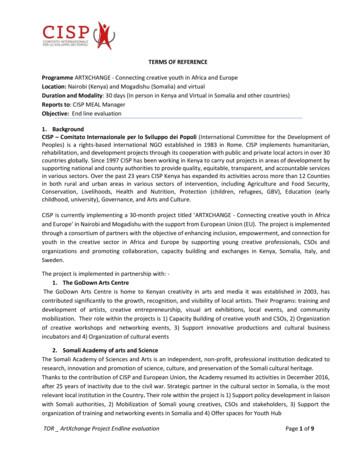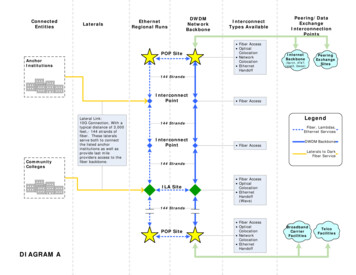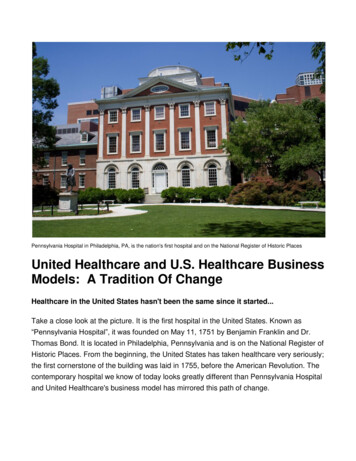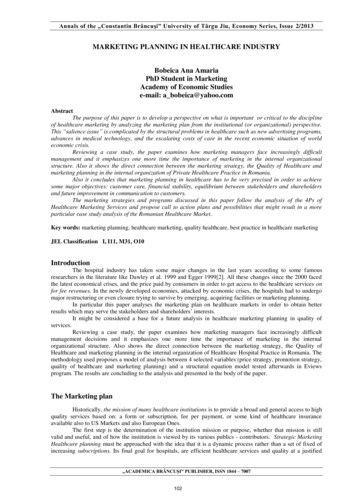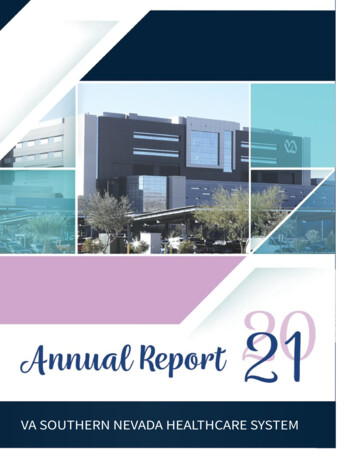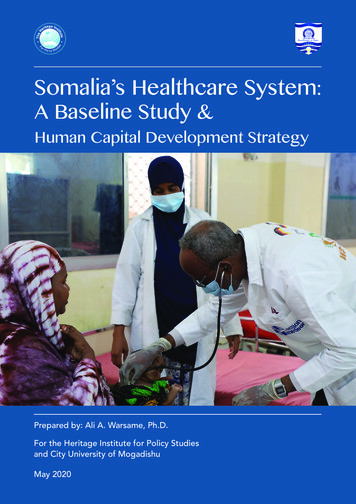
Transcription
Somalia’s Healthcare System:A Baseline Study &Human Capital Development StrategyPrepared by: Ali A. Warsame, Ph.D.For the Heritage Institute for Policy Studiesand City University of MogadishuMay 20201 Heritage InstituteCity University
Copyright 2020 The Heritage Institute for Policy Studies, City University of MogadishuAll Rights Reserved.The opinions expressed in this publication are the responsibility of the author(s).Readers are encouraged to reproduce material for their own publications, as long as they are notbeing sold commercially. As copyright holder, the Heritage Institute for Policy Studies and CityUniversity of Mogadishu requests due acknowledgement and a copy of the publication. For online use,we ask readers to link to the original resource on the HIPS website. Heritage Institute for Policy Studies and City University of Mogadishu, 2020.2 Heritage InstituteCity University
Contents3 Heritage InstituteAcknowledgement5List of Acronyms6Executive Summary71.0: PART ONE81.1: Setting and Background81.2: A historical look at Somalia’s health sector1.2.1: Traditional Medicine881.2.2: Healthcare during the colonial era91.2.3: Healthcare from 1960-199191.2.4: Healthcare during the civil war101.2.5: Slow recovery and current outlook101.3: Situation analysis, issues and trends111.3.1: Healthcare infrastructure111.3.2: Public health facilities131.3.4: The private healthcare system141.3.4: Healthcare financing151.3.5: Health governance161.3.6: Health regulations capacity171.3.7: Health sector policy and plans181.3.8: Health information System181.3.9: Recent health indicators181.3.10: Under-five, infant and neonatal mortality211.3.11: Maternal Mortality221.3.12: Sanitation231.3.13: Communicable Deceases241.3.13.1: HIV241.3.13.2: Tuberculosis (TB)251.3.14: Non-communicable diseases (NCD)262.0: PART TWO272.1: Human resource for health (HRH)272.3: Human capital development: a brief literature review302.4: Human capital and health: a critical link312.5: Setting the context322.6: Theoretical framework322.7: Introduction to the study342.8: Specific objectives342.9: Methodology352.10: Data analysis and reporting362.11: Limitations37City University
4 Heritage Institute3.0: PART THREE: KEY FINDINGS373.1: Introduction373.2: The state of public health facilities383.3: State of health workforce413.4: Enabling environment473.5: Health professional training institutions473.6: Essential health workforce and health technicians533.7: Female health workers543.8: Contracting arrangements of public-private partnerships563.9: Continued professional development programs573.10: Computer-based distance health learning methods573.11: Deployment, retention and management of the health workforce583.12: Health workforce regulations593.13: Health workforce financing603.14: Health workforce information systems613.15: Building partnerships with stakeholders623.16: Public-private partnerships633.17: Engaging the Somali diaspora634.0: PART FOUR644.1: COVID 19 Pandemic implications for the Somali health workforce644.2: Government efforts to contain COVID-19664.3: COVID-19 prevention and control664.4: Human capital: A critical factor in fighting the pandemic664.5: Formidable challenges:674.6: The way forward685.0: PART FIVE: CONCLUSION706.0: PART SIX: STRATEGY FOR IMPROVING THE STATE OFHEALTHCARE IN SOMALIA726.1: Rationale726.2: Vision726.3: Mission726.4: Goals736.5: Objectives736.6: Strategy74City University
AcknowledgementI am indebted to colleagues at the Heritage Institute for Policy Studies (HIPS) and City University ofMogadishu, their leadership and staff for providing me with a support base, which enabled me to takeup this research. I am also grateful to all the research experts and fellows at HIPS for their contribution.Across Somalia, at both the Federal Government of Somalia (FGS) and the Federal Member State (FMS)level, there are many people to recognize and to thank for the successful completion of this study as wellas the participants and contributors to the study including health authorities, health professionals,academia, health professional associations, the private sector and development partners.Ali Abdullahi Warsame, Ph.D5 Heritage InstituteCity University
List of AcronymsANC Antenatal careHCsHealth centersBEmONC Basic emergency obstetric and neonatal careHINARI Health InterNetwork Access to Research InitiativeCDS Communicable diseases surveillanceHMIS Health management information systemCPD Continuous professional developmentINGOsInternational non-governmental organizationsCT/ART Computed tomography/antiretroviral therapyMHCs Mental health centersCVD Cardiovascular diseaseMoH Ministry of HealthCOPD Chronic obstructive pulmonary diseaseMOPIED DHO District Health OfficeMinistry of Planning, Investment andEconomic DevelopmentDHIS District health information softwareNDP9 National Development Plan 9EMR Eastern Mediterranean regionNHPC National Health Professional CouncilENC Essential newborn careOECD Organization for EconomicCo-operation and DevelopmentFGM/C Female genital mutilation/cuttingPHUsPrimary health unitsFGS Federal Government of SomaliaRFCs Referral health centersFRS Federal Republic of SomaliaRHs Regional hospitalsFHW Female health workerRHO Regional health officesCBFHWsCommunity-based female health workersSBAs Skilled birth attendantsDeutsche Gesellschaft fürInternationale Zusammenarbeit(German Society for International Cooperation)SDGs Sustainable Development GoalsSARA Service Availability and Readiness AssessmentHDI Human Development IndexUHC Universal health coverageHIV Human immunodeficiency virusUNFPA United Nations Fund for Population ActivitiesHRH Human resource for healthUN United NationsHCDM Human capital development mechanismUNDP United Nations Development ProgramHHC Health human capitalWASH Water, sanitation and hygieneWHO World Health OrganizationYLL Years of lives lostGIZ 6 Heritage Institute City University
Executive SummaryOver the past three decades, Somalia has been an arena for endless armed conflict and natural disasters.The consequences of these events on the health sector in general and the health workforce, in particular,have been devastating, affecting the entire health service delivery. This study, commissioned by the HeritageInstitute for Policy Studies (HIPS) and City University of Mogadishu, was conducted to assess the state ofhealthcare in Somalia as it relates to human capital in the sector. The study also aims to provide an analysis ofcurrent challenges but also to put forward remedial solutions for system-wide recovery strategies.Specifically, the study sought to identify health workforce shortages and skills gaps and to explore waysto overcome human capital development-related challenges.Moreover, the study looked into existing policies, programs and health professional education institutions.Health authorities at the federal and member state level, the private health sector, health professional traininginstitutions, health professional associations and development partners assisted with this study. Qualitativeinterpretative research was used as well as data collection methods, including key informant interviews,document review and analysis and focus group discussions.The overall findings of this study show that healthcare services in Somalia are highly inadequate and thehealth workforce lacks the skills, knowledge, legal instruments and the necessary resources to do their jobs.Other findings include: Healthcare services, both public and private, are ill equipped to meet even the primary health serviceneeds of the bulk of the population;There is a scarcity of all categories of health workers, particularly mid-level professionals and physicians;There are considerable gaps in skills;There is an improper allocation of health workforce (urban vs. rural);Retention and motivation schemes are weak;There is an inadequate enabling environment for the health workforce;Training institutions are substandard and unregulated;There is an absence of adequate government oversight for the health workforce; andThere are few health professional training institutions in the face of a rapid population increase.These systemic inadequacies and challenges require an urgent scale-up of the production, training and skillsenhancement of the health workforce. A continuing education program is needed to secure the attainment ofuniversal health coverage (UHC) and health-related sustainable development goals (SDGs) and targets. Inservice training activities could increase the knowledge and skills of healthcare workers andsystematically and sustainably enable them to attain higher competencies that will help them to producedesired health outcomes. The study presents a strategic direction through which Somalia could overcomethe current health workforce shortage and skills gaps through a development process that provides clearobjectives and how to achieve them.7 Heritage InstituteCity University
1.0: PART ONE1.1: Setting and backgroundWith a population of 15.44 million in 2019, Somalia is a young and rapidly expanding nation with an annualpopulation growth of three percent. Since the late 1980s, Somalia has experienced armed conflict, violenceand a series of natural and man-made disasters which resulted in a long, drawn-out and comprehensive statecollapse.With a populationof 15.44 million in2019, Somalia is ayoung and rapidlyexpanding nationwith an annualpopulation growthof three percent.Consequently, Somalia ranks at the bottom among the least developed nations and is one of the poorestcountries in the world. In 2017, Somalia ranked the lowest globally in all dimensions of the HumanDevelopment Index (HDI) at 0.251 overall (the lowest in the world), of which health is at 0.514. Accordingto the Corruption Perceptions Index released by Transparency International in 2019, Somalia was the mostcorrupt nation globally (180 out of 180 countries, with a corruption rating of 9/100).1It is not a surprise that the country currently has some of the lowest health and well-being indicators globally.Extended periods of conflict and insecurity exacerbated by recurrent extreme droughts and floods andsubsequent food insecurity have devastated the health status of the population and severely damaged itsfragile health system. Droughts result in displacements, which leads to unprecedented levels of malnutrition,health emergencies and epidemics. A large proportion of the population is prone to a wide range of naturaland human-induced disasters due to Somalia’s geography and setting.2The country’s overall morbidity and mortality remain very high, particularly women and children. Somaliacurrently has the world’s highest child mortality rate. One out of seven children dies before the age of five.Somali mothers suffer from the sixth highest maternal death risk in the world, with skilled health personnelattending only one in 10 births. The average Somali woman has 6.7 children, the fourth highest fertility ratein the world.3Despite the immense challenges, the country’s health sector is emerging from the crises and is forging apath forward. The country is re-establishing health governance structures, rebuilding health institutions,re-engaging with development partners, and adopting a decentralized health governance system throughministries of health at the federal and member state levels.4Somali traditionalmedicine could bedivided into Islamicmedicine, practicaltreatments andherbalism.1.2: A historical look at Somalia’s health sector1.2.1: Traditional medicineHistorically, traditional medicine was used for curing diseases. Somali traditional medicine could be dividedinto Islamic medicine, practical treatments and M; scale: 100 (very clean) to 0 (highly /somalia-population/3WHO Somalia Country Cooperation Strategy 2019-23.4WHO Somalia Country Cooperation Strategy 2019-23.28 Heritage InstituteCity University
The religion grounded treatments were entirely based on the teaching of Islam and were used for bothphysical and mental illnesses while the practical and herbal treatments focused on bodily sickness. Thesetraditional forms of treatment, which included cauterization, scarification and bloodletting were the onlyservices available to the vast majority of the Somali people. Even today many Somalis still rely on traditionalmedicine as their primary source of healthcare.51.2.2: Healthcare during the colonial eraModern medical practices in Somalia date back to the arrival of European colonialism in the late 1880sand started with the establishment of some ambulatory6 services by the British and Italian colonialadministrations. As was the case in other African colonies, medical services were at the center of thecolonial imperative and had two core functions: In 1972, healthcareservices werelargely centralizedby the then militarygovernmentand much of thenational budgetwas devoted to themilitary, leavinglittle money forhealthcare.To offer medical treatment to the colonial soldiers, missionaries, colonial officials and their families and,to a lesser extent, treat native Somalis who collaborated with the colonial administrations; andTo use medical treatment to help spread their religion, i.e. Christianity.7In the 1930s, the Italian colonial administrations built some district-level facilities, mostly in the south of thecountry, to provide basic curative, preventive medical and maternity services. De Martino Hospital8 inMogadishu was one of these facilities. It was only after World War II that things started to improve, and moredistrict-level hospitals were functioning in some towns. However, due to the distrust that existed betweenSomalis and the successive colonial administrators, healthcare development was minimal.9 Some of the mostcommon diseases included waterborne diseases, infectious diseases and tropical diseases such as malaria,tuberculosis and leprosy.101.2.3: Healthcare from 1960-1991Before the collapse of the state institutions in early 1991, Somalia had a rudimentary public health system,which was reasonable by African standards. Civilian and military administrations had painstakingly built thissystem over the previous 30 years. The ministry of health supervised the organizational and administrativestructure of the sector, though regional medical officials enjoyed some authority. In 1972, healthcare serviceswere largely centralized by the then military government and much of the national budget was devoted to themilitary, leaving little money for healthcare.From 1973 to 1978, there was a substantial increase in the number of physicians, and a far greater proportionof them were Somalis. Of 198 physicians in 1978, a total of 118 were Somalis, compared with 37 out of 96in 1973. In the 1970s, an effort was made to increase the number of other health personnel and to foster theconstruction of health facilities. To that end, two nursing schools opened and several other health-relatededucational programs were instituted. Of equal importance was the countrywide distribution of medicalpersonnel and facilities. In the early 1970s, most personnel and facilities were concentrated in Mogadishuand a few other major towns. The situation had improved somewhat by the late 1970s, but the distributionof healthcare remained unsatisfactory.5Elmi, A.S (1978). Research into medicinal plants: The Somali experience: Department of Pharmacology, Somali NationalUniversity, Mogadishu-Somalia.6Ambulatory medical service is a medical care provided on an outpatient basis, including diagnosis, observation,consultation, treatment, intervention and rehabilitation services.7Nakityo: The Early History of Scientific Medicine in Africa (1968). W.D Foster, East African Literature Bureau, Nairobi,Kenya.8Herbert L. Bodman, et.al, (1998), Women in Muslim Societies: Diversity Within Unity, Lynne Rienner Publishers.9WHO Somalia Country Cooperation Strategy 2019-23 Somalia.10Thomas Lothar Weiss (2009), Migration for Development in the Horn of Africa: Health expertise from the Somali Diaspora inFinland, International Organization for Migration (IOM).9 Heritage InstituteCity University
The Somali health system was already in disarray at the time of the Siad Barre government, with wideinequalities in access to health services between Mogadishu and the rest of the country. However, accordingto the policy adopted at the time, health and education were free. The capacity of transforming policies intoaction was limited, and so were the resources, largely provided by international assistance (94 percent of thehealth budget in 1989). As a result, an indigenous, coherent health system never took off and no sector-wideadoption of the primary healthcare approach took place in those years.Government spending for health progressively declined, from four to five percent of total spending in the1970s and beginning of the 1980s to only two percent by the second half of the 1980s. Access to healthcarefurther diminished, with only Mogadishu and areas supported by the international community providingsome health services. The overall impact on the health system has been profound, affecting all itscomponents: human resources, infrastructure, management, service delivery and support systems.10In the late 1980s, with instability increasing and the economy in shambles, health professionals began leavingSomalia to seek better opportunities abroad, creating large vacancies at all levels. By 1990 most medicalspecialists had left the country, leaving only a few general practitioners. This brain drain has severely affectedthe health sector, and most basic health services are often made impossible by the absence of qualifiedmedical doctors, midwives, nurses and other health personnel.111.2.4: Healthcare during the civil warA significantnumber of medicaldoctors, qualifiednurses, midwivesand skilled healthtechnicians wereeither killed ormigrated overseas.Somalia’s already modest health infrastructure was destroyed or seriously damaged during the devastatingcivil war. Most health premises were looted, vandalized or taken over by squatters, internally displacedpeople and armed clan militias. A significant number of medical doctors, qualified nurses, midwives andskilled health technicians were either killed or migrated overseas.12 Virtually all health-training institutionswere either looted or destroyed, creating a large and acute shortage of qualified health workers. By the 1991-1993, an estimated 90 percent of the population had no access to basic healthcare. Non-governmentalorganizations, emergency aid organizations and the private sector stepped in to haphazardly fill the vacuumleft by the collapse of the state sponsored healthcare system.1.2.5: Slow recovery and current outlookThe vanishing of the state system has given way to alternative and non-governmental healthcare initiativesthat have sprung up in all states and regions. Initiatives by private entrepreneurs, local authorities,international development partners and international non-governmental organizations have resulted inthe establishment of healthcare providers of varying quality throughout the country. Even though theseinitiatives have considerably expanded the availability and accessibility of basic healthcare services, the bulkof the Somali population, particularly in rural and nomadic settings, do not have access to any healthcareservices.10Health system profile Somalia (2006): Regional health systems observatory, WHO.WHO Somalia Country Cooperation Strategy 2019-23 Somalia.12Weiss, Thomas, Lothar (2009). International Organization for Migration (IOM). Migration for Development in the Horn ofAfrica. Health expertise from the Somali Diaspora.1110 Heritage InstituteCity University
1.3: Situation analysis, issues and trendsSince the collapse of the central government, the Somali health sector has experienced severe challenges,among them: Severe shortages of skilled workers; Inadequate financing; Unequal access to quality services; Lack of integrated health information systems; Inadequate balancing between humanitarian and development/recovery response; Weak managerial and governance systems; Limited institutional capacity; Lack of regulation; Limited leadership experience; Donor dependency; and Unaffordable and substandard private sector dominated services.1.3.1: Healthcare infrastructureThe current Somali public healthcare system comprises four levels, namely: Primary Health Units (PHUs) in rural areas Health Centers (HCs) at the sub-district level Referral Health Centers (RFCs) in districts Regional Hospitals (RHs) located in the regional capitals; and Tuberculosis Centers (TBCs), Computed Tomography/Antiretroviral Therapy(CT/ART) facilities and Mental Health Centers (MHCs).The 2016 Service Availability and Readiness Assessment (SARA) survey13 assessed the healthcareinfrastructure and its responsiveness in providing key services. The SARA report found a total of 1,074health facilities in the country, of which only 799 were operational and accessible, indicating an acuteshortage, including private health facilities. The cumulative score of the density of public health facilities,in terms of inpatient and maternal beds, was 28.3 percent, reflecting a 72 percent deficit in the healthinfrastructure. At the same time, the core health workforce density was 18.6 percent, and service utilizationlevel 6.3 percent, which collectively provide a total general service availability rate of 17.7 percent.Furthermore, the availability and implementation of infection control guidelines at the facility level werecritical. On average, the infection control readiness score of all the facilities was 62 percent, and only 20percent of facilities had all infection control prevention standards and precautions. The overall availability ofroutine laboratory tests at health facilities was only 19 percent.1311 Heritage InstituteThe Service Availability and Readiness Assessment (SARA). WHO report 2016.City University
Only four percent of the facilities performed all the diagnostic tests on-site, and blood glucose testing wasavailable in only seven percent of the facilities, suggesting that the majority of pregnant women turn to theprivate sector for most laboratory investigations, posing affordability problems.The survey illustrated that 66 percent of the facilities provided antenatal care (ANC) services, although notcomprehensively, with 43 percent of facilities providing less than half of the service components. ANC isessential for the detection and treatment of any emerging health problems during pregnancy.The mean availability of Basic Emergency Obstetric and Neonatal Care (BEmONC) services was 45 percentin urban facilities and 20 percent in rural areas. Essential Newborn Care (ENC) was offered in 29 percent ofurban and 12 percent of rural facilities. The assessment revealed that less than half (49 percent) of the healthfacilities provided routine childhood immunization, while outreach services were offered by only13 percentof the facilities.According to the survey finding, 89 percent of referral health centers, 87 percent of health centers, and 50percent of hospitals offered child immunization, while only six percent of health posts/primary health unitsdid so. The critical child preventive and curative care services were provided by 526 (66 percent) of thefunctioning facilities.The survey findings clearly show inadequate availability of basic sanitation, consultation rooms, improvedwater sources and power supply, communications equipment and emergency transport. Only 46 percent ofhealth facilities had access to an improved water source; 41 percent had no consultation rooms; 72 percentlacked any power source and 84 percent were without emergency transport to facilitate the urgent referral ofhigh-risk pregnancies. Moreover, only one percent of the health facilities in the country had all the necessaryhealth system amenities. The density of key health facilities14 necessary to serve the population was also amajor problem. This leads to fewer patients seeking treatment as they must travel long distances to get toinadequately staffed and under resourced health centers.Table 1 - Somalia - Health Facility Inpatient & Maternity Bed Density Indicators (2016)15SOMALIA - Health Facility Inpatient andMaternity Bed DensityPresent statusTargetDensity Score (%)*Health facility density per 10,000 population0.76238Inpatient bed density per 10,000 population5.342521Maternity bed density per 10,000 population2.551025Infrastructure density (average score of facility density,inpatient bed density and maternity bed density))N/A10028Outpatient visits per person per year0.2355Hospital discharges per 100 per year0.81108Physicians, nurses, and midwives per 10,000 population4.2844.519*The country’s accomplished rate (2016) towards the density target indicator to be achieved for the developmentof each of the three priority health infrastructures14The number of health facilities per population of 10,000 in a designated area. Health facilities include all public, private, nongovernmental and community-based health facilities defined as a static facility(i.e., has a designated building) in which general health services are offered.1512 Heritage InstituteThe Service Availability and Readiness Assessment (SARA). WHO report 2016.City University
1.3.2: Public Health facilitiesPublic health facilities are distributed around the regions, districts and sub-district level rural areas. Thesparse population density, lack of roads and poor health-seeking behaviors by the communities aresignificant factors in the low utilization of high-value reproductive health services both at the primaryhealthcare level and at the essential referral support level.Table 1.2: Somalia - Functional Public & Private Health Facilities by Zone/Region(2016)16SOMALIA - HealthFacilityTypeCentral and South H 352641001RHC/District HospitalHealth Facility typeCRegional/Tertiary Hospital87entral and South Somalia11511Total226Figure 1.1 - SOMALIA - Public Healthcare Delivery System Diagram17Facility Based ServicesThe Four AdditionalProgrammesThe Six Core Programs Maternal, reproductive healthand neonatal health nutrition Child health nutition CDC, Surveillance and WATSAN First aid and care of critically illand injured Treatment of common ilness HIV, STI and TB Management of chronic diseases,other diseases, care of elderly andpalliative care Mental health and mental disability Dental health Eye healthFemale Community Based Health Workers(Marwo Caafimaad)Community Based Services Financing Human resource managment and development EPHS coordination, development and supervision Community participation Health system support components Health management information systemManagement and support components161713 Heritage InstituteThe Service Availability and Readiness Assessment (SARA). WHO report 2016.Country Cooperation Strategy WHO and Somalia (2019-23), 1 July 2019.City University
Figure 1.2 - Somalia - Healthcare Center Density Map (2016)181.3.3: Private healthcare systemPrivate provisionof health servicesin the country isunregulated andcan sometimespose a risk ratherthan a solutionto the country’shealth problems.During the past two decades, the Somali private healthcare sector has shown significant growth and nowincludes private for-profit institutions, private non-profit facilities (including training institutions, small-scaleclinics and diagnostic facilities) and large hospitals providing specialized care. The sector currently providesaround 80 percent of all curative care services.19Public health services are insufficient or even nonexistent inmany parts of the country, particularly in the southern and central regions, and demand for health servicesis met mostly by the private sector.20 According to SARA, in 2016 there were approximately 3,289 privatehealth facilities in Somalia. Overall, 79 percent of private facilities are in urban areas and 20 percent in ruralareas. Puntland has a significantly higher proportion of facilities in rural areas than elsewhere in the country.The majority (58 percent) of facilities are pharmacies or dispensaries, while four percent health facilities, withthe exception of hospitals, are owned by individuals. Private provision of health services in the country isunregulated and can sometimes pose a risk rather than a solution to the country’s health problems. The lackof external support and development partners and a shortage of qualified personnel further complicates thesituation. Nonetheless, the private sector is a crucial healthcare player and could be platform for providingpublic health services at affordable prices, as happens in many developing countries. However, reliable data onthe size of the private health sector in Somalia is not available.2118WHO Health Facility Assessment Somalia 2016.Country Cooperation Strategy WHO Somalia (2019-23).20Strategic review of the Somali health sector: challenges and prioritized actions: Report of the WHO \mission to Somalia, 11–17September 2015.21Strategic review of the Somali health sector: challenges and prioritized actions: Report of the WHOmission to Somalia, 11–17 September 2015.1914 Heritage InstituteCity University
Table: 1.3: Private healthcare system delivery in Somalia (2018)1,0362287461,2793,289%6 percent32 percent4 percent58 percent100 percentSomali governmentspending oncitizens' healthcareamounted to lessthan five percent ofthe total healthsector expenditure.0.93Source: OPM/ UNICEF (2018): Assessing the capacity of the private health system in Somalia.1.3.4: Healthcare financing
3 Heritage Institute City University Contents Acknowledgement List of Acronyms Executive Summary 1.0: PART ONE 1.1: Setting and Background 1.2: A historical look at Somalia's health sector 1.2.1: Traditional Medicine 1.2.2: Healthcare during the colonial era 1.2.3: Healthcare from 1960-1991 1.2.4: Healthcare during the civil war




